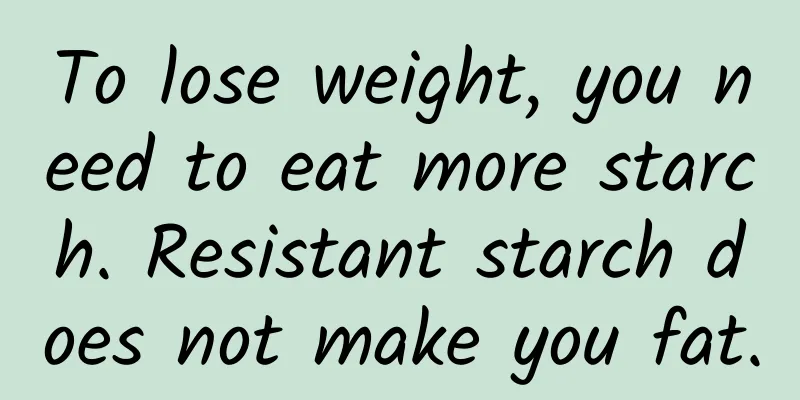To lose weight, you need to eat more starch. Resistant starch does not make you fat.

|
Who said "You can't eat starch when losing weight?" This is a wrong concept, don't fall into this myth! Dr. Lin Zhengyi, who has many years of experience in weight loss clinics, said that many people have tried to lose weight by reducing or even cutting out starchy foods before seeking help from weight loss clinics. However, due to incorrect methods and concepts, not only are the results ineffective, but they may even cause damage to body functions, and weight loss is ineffective and harmful to the body. Although resistant starch can help with weight loss, not all staple foods in the three meals can be replaced by resistant starch. Dr. Lin Zhengyi, a family medicine doctor, pointed out that in addition to providing the calories needed for daily activities, appropriate starch also plays an important role in helping the body burn fat and avoiding the consumption of protein in the body, so it is more important to eat starch when losing weight. What is important is how to choose the type of starch wisely. Resistant starch can help you lose weight without getting fat To put it simply, "Resistant Starch" (RS) is starch that is difficult to be broken down by the human body's digestive enzymes. A further explanation is that after this type of starch is ingested by the human body, it can resist the starch-degrading enzymes secreted by the small intestine, and thus cannot be absorbed by the small intestine, but can be used by the large intestine. It has a function similar to dietary fiber. Nutritionist Yang Shangwen said that "resistant starch" is a staple food that can help you lose weight and prolong your feeling of fullness, allowing you to eat starch without worrying about getting fat and making weight loss more effective. Resistant starch can be divided into four categories according to its properties. The first category is starch that cannot be broken down by digestive enzymes due to physical barriers (such as shells), such as unrefined starch from seeds, beans, whole grains, etc. The second type is starch that is in granular form and difficult to digest, such as raw potatoes and unripe bananas. The third category is aged starch that has been cooled after cooking, such as overnight rice, sushi, and cold noodles; the fourth category refers to starch that has been chemically modified and is difficult to digest. There are many types of non-natural starch, such as some food additives. Resistant starch helps with weight loss 1. Lower calories and higher satiety: Ordinary starch can provide 4 calories per gram, but "resistant starch" is difficult to digest and absorb, and can only provide 2.8 calories per gram, and can increase the time that food stays in the gastrointestinal tract. Therefore, when taking the same amount of starchy foods, choose foods that are higher in resistant starch, which are lower in calories and easier to make you feel full, and can be used more often during weight loss. 2. Helps burn fat and control blood sugar: In addition to being low in calories, studies have also shown that consuming an appropriate amount of resistant starch (5.4%) in a meal can help burn and oxidize fat and accelerate fat metabolism. After consuming resistant starch, blood sugar and insulin levels in the body are lower, indicating that it is also helpful for controlling blood sugar. 3. Promote defecation and maintain intestinal health: Resistant starch cannot be digested and absorbed in the small intestine, but after entering the large intestine it can provide space for the growth of probiotics, promote intestinal motility, increase stool volume, contribute to intestinal health, and improve constipation caused by reduced food intake during weight loss. Principles of choosing resistant starch in daily diet 1. Natural ones are better than refined ones: The content of resistant starch will be reduced due to food processing, grinding, and refining. Therefore, the staple starch choice can choose less processed brown rice, oats, whole grain rice, and multi-grain bread to replace white rice and white toast. 2. It is better to cook than to fry: The content of resistant starch will decrease depending on the cooking method, so try to eat food raw if it can be eaten raw; if the food needs to be cooked, use steaming instead of roasting, frying, or baking, and shorten the cooking time to increase the content of resistant starch in the food. 3. Cold is better than hot: The content of resistant starch will increase or decrease with temperature changes. For example, cold sushi, overnight rice, cold noodles, potato salad, etc. have a higher content of resistant starch, which will decrease after heating. Nutritionist Yang Shangwen said that there are many easily available resistant starch foods in our daily diet, such as bananas, but we should choose unripe green ones as they contain more resistant starch. Ripe yellow bananas, on the contrary, are high in sugar and have a higher GI value, and are not suitable for consumption when losing weight. Cooked sweet potatoes, cooled cooked corn, pasta, etc. are also food items high in resistant starch. Doctor Lin Zhengyi also reminded that although resistant starch can help with weight loss, not all staple foods for three meals can be replaced by resistant starch; especially for people with weaker gastrointestinal systems, consuming too much resistant starch may cause indigestion and stomach pain. It is recommended to replace one meal with resistant starch, and drink more water to promote metabolism. ★《Don’t make the wrong choice! 》Jolin loses body fat and really loses weight |
<<: Don’t touch these three fattening breakfasts! Avoid eating too much and gaining weight
>>: A nurse lost 14 kg in 75 days and did this to lose fat
Recommend
What causes women to develop cervical precancer?
If cervical erosion is not treated for a long tim...
The more you eat, the thinner you get? 4321 Golden Plate Decrypted! Nutritionists teach you 5 tips to eat your way to a lean body
Is it possible to “eat more and lose weight”? Nut...
Symptoms and treatments of amenorrhea Causes of amenorrhea
Amenorrhea refers to the cessation of menstruatio...
The calorie ranking of mooncakes: This one is close to 700 calories! Baking low-calorie fruit pie in an electric pan is healthy and has no burden
The Mid-Autumn Festival is approaching and all ki...
Several common complications of adnexitis
Adnexitis is one of the most serious gynecologica...
Common causes of white lesions on the vulva
What causes white lesions of the vulva? White les...
Night owls tend to gain weight! Drink slimming tea to reduce edema
The night is more beautiful? For obese people, be...
How much does it cost to test for adenomyosis?
We know that a disease needs to be diagnosed thro...
What should I do if my progesterone level is low and my period does not come?
What should I do if my progesterone level is low ...
Back pain: Beware of uterine fibroids
Will uterine fibroids cause back pain? Many patie...
The most common symptoms of dysmenorrhea in life
Among the many gynecological diseases in women, d...
Female friends must not underestimate irregular menstruation.
Female friends must not underestimate the harm of...
Modern treatment of cervical precancerous lesions
There are many causes of cervical precancerous le...
What kind of surgery is suitable for myoma on the posterior wall of the uterus?
What kind of surgery is suitable for myoma on the...
"Obesity" is closely related to 13 types of cancer! 168Is intermittent fasting and ketogenic diet suitable for you?
After the Mid-Autumn Festival and National Day ho...









